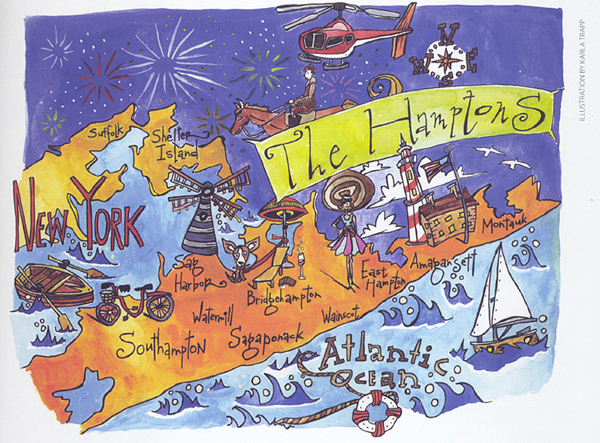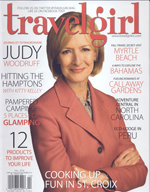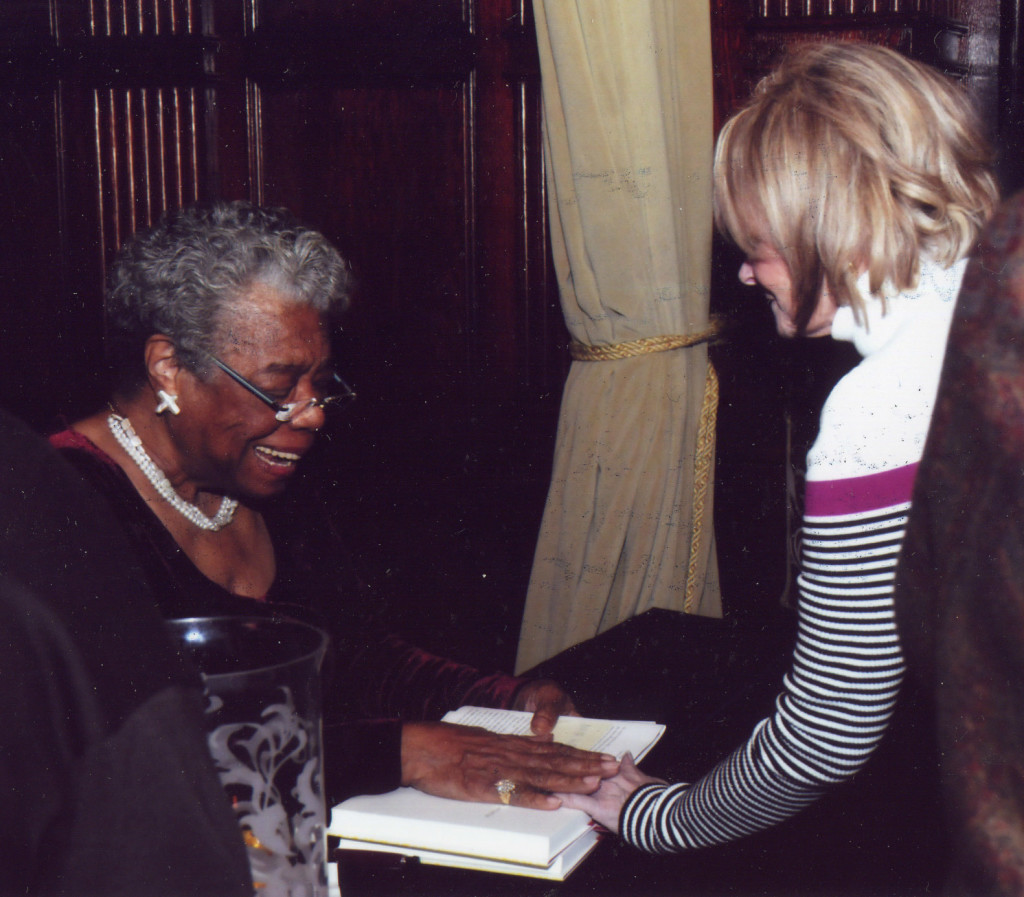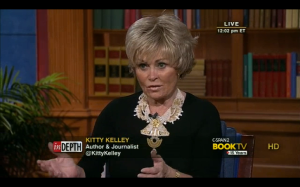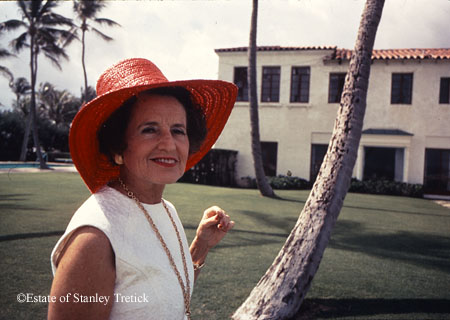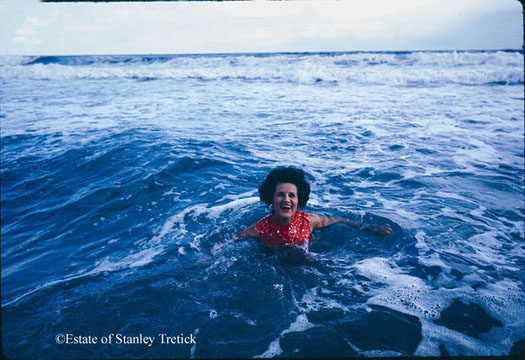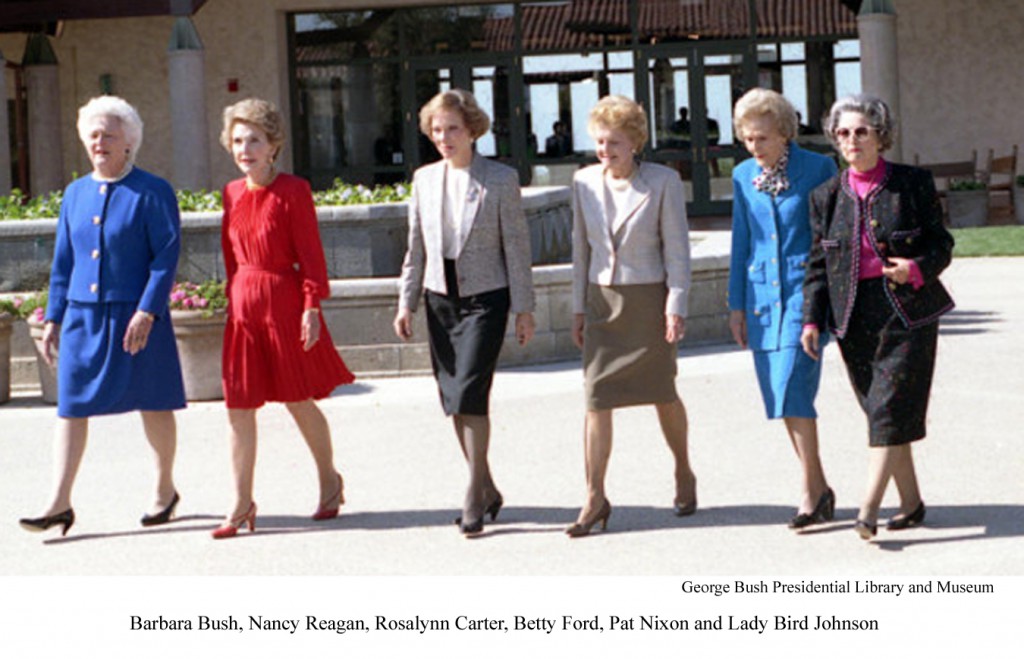The Hamptons
by Kitty Kelley
The little girl looked forlorn. Standing in the Starbucks line in East Hampton, she tugged at her mother’s cashmere sleeve, almost in tears. “Oh, Mummy,” she said. “I forgot to kiss Daddy good-bye this morning before he got in the helicopter.”
This child of the “one percent” summers with her prosperous parents on the luscious East End of Long Island known as “The Hamptons,” a term that annoys many locals, who prize the uniqueness of each little village and hamlet tucked into the 27 miles from Montauk Point to East Hampton, including Wainscot, Sagaponack, Bridgehampton, Water Mill, Southampton, Sag Harbor, Amagansett and Shelter Island, which can only be approached by ferry.
“The Hamptons” conjures the good life of pristine beaches, million dollar mansions, gleaming yachts, and emerald green golf courses where even the sand traps glisten. In addition, the area boasts windmills, horse farms, flowered meadows, rolling fields of corn, and acres of vineyards. The food is farm fresh and, just like Provence, there is a farmer’s market every day in a different town offering fresh fruits and vegetables, sunflowers, eggs still warm from the hen house and even fresh chicken.
For foodies, there are gourmet chefs and starred restaurants, notably Nick and Toni’s (East Hampton), Tu Tu Il Giorno (Sag Harbor), Tom Colicchio’s Topping Rose House and Pierre’s (Bridgehampton). The most romantic restaurant by far is the bricked alley of Sant Ambroeus (Southampton). The orchids cascading from the walls and candles flickering at small tables make you feel like Cinderella with two glass slippers, plus the fairy godmother who grants your every gourmet wish from fresh seafood to locally harvested wines. Plus—all the waiters look (and act) like Prince Charming.
“The Hamptons” also mean celebrities, celebrities, celebrities. In East Hampton you’re bound to see Alec Baldwin with his yogi wife, Hilaria, carrying their baby down Main Street. If you breakfast at the American Hotel in Sag Harbor, you can be sure the man ordering an egg white omelet is the former president. Bill and Hillary Clinton (a k a “Billary”) are summer regulars. Kitchen czarinas like Martha Stewart and Ina Gartner are fixtures as are tycoons like Ron Perlman (Revlon), Ronald Lauder (Estee Lauder), and Len Riggio (Barnes & Noble). Don’t be surprised if you see Howard Schultz, CEO of Starbucks, standing at the door welcoming customers.
Fashionistas love spotting Tory Burch, Calvin Klein and Ralph Lauren and fans occasionally glimpse Madonna, Paul McCartney, Jon Bon Jovi, Jerry Seinfeld, Sarah Jessica Parker, Mathew Broderick, Jennifer Lopez, Kelly Ripa, Andy Cohen, Gwyneth Paltrow, Mariska Hargitay and Christie Brinkley, who in her 60’s looks better than when she was as Billy Joel’s “Uptown Girl.”
The main streets of every town in the Hamptons are filled with bistro bars, patio restaurants, antique shops, and pricey boutiques. You’ll find many of your favorite labels at the shops of Ralph Lauren, InterMix, J.Crew, Wonder, Tory Burch, Michael Kors, Calypso, J. McLaughlin., Theory and Eli Tahari. In East Hampton you can buy a cashmere sweater for $1250 at Brunello Couchinelli or an $18 t-shirt from Bookhampton that says, “I Believe in Books.” (I skipped the sweater and bought the t-shirt).
While in East Hampton make your way to The Monogram Shop on Newtown Lane for anything you want personalized from finely stitched pillow cases, bathrobes and night gowns to beach bags, sun bonnets, glasses, placemats, napkins (paper or linen) stationary, invitations, and place cards for your dinner parties (the funniest being monogrammed Stop Talking beneath which the impish owner, Valerie Smith, wrote the name of Bill O’Reilly). She also sells 16 oz. shatter-proof glass cups that go in the dishwasher and—ta dah—predict presidential elections.
“The cups know,” said Smith. “The cups always know.” Since 1994 she has been monogramming political cups—last ones were Obama/Biden and Romney/Ryan. “I keep a daily tally of how many sold and post it in the window so passers-by can see the results, and every four years my cups have accurately predicted the presidency.”
Beyond the glitz and glamour of the Hamptons is a cornucopia of culture—theater, music, dance, art, film, and spectacular garden tours. Nearly every night in the summer there is a charity event open to the public for a price to raise money for every good cause from local schools and libraries to hospitals and hospices. Not to be missed is an evening of Shakespeare Under the Stars at Mulford Farm in East Hampton presented by HITFest (Hampton Independent Theater Festival). Bay Street Theater in Sag Harbor offers a summer comedy series and top-quality productions by Equity actors. One of the funniest evenings is “Celebrity Autobiography” at Guild Hall in East Hampton, featuring a troupe of actors reading inanities from books written by celebrities like Dolly Parton, Arnold Schwartzenegger, and Tony Danza.
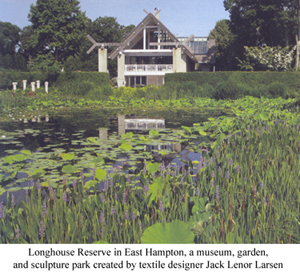 An absolute must-see is Longhouse Reserve in East Hampton, the 16 acre sculpture garden created by world-renowned textile designer Jack Lenor Larsen. He has filled his little piece of paradise with towering oaks, weeping Japanese cherry trees, and Hemlock hedges surrounded by flowers in full bloom year round. You will be mesmerized by the marriage of art to nature as you stroll through 37 pocket gardens under rose-entwined arches. Wandering around ponds teeming with lilies, and pools bedecked by outdoor furniture as colorful as a peacock’s feathers, you will see sumptuous sculptures–a deKooning here and a Chihuly there. Yoko Ono’s mammoth white marble chess set gleams in a green garden not far from an arresting fiberglass dome designed by Buckminster Fuller.
An absolute must-see is Longhouse Reserve in East Hampton, the 16 acre sculpture garden created by world-renowned textile designer Jack Lenor Larsen. He has filled his little piece of paradise with towering oaks, weeping Japanese cherry trees, and Hemlock hedges surrounded by flowers in full bloom year round. You will be mesmerized by the marriage of art to nature as you stroll through 37 pocket gardens under rose-entwined arches. Wandering around ponds teeming with lilies, and pools bedecked by outdoor furniture as colorful as a peacock’s feathers, you will see sumptuous sculptures–a deKooning here and a Chihuly there. Yoko Ono’s mammoth white marble chess set gleams in a green garden not far from an arresting fiberglass dome designed by Buckminster Fuller.
On summer weekends the main roads of the Hamptons are clogged with Jaguars and Ferraris. The traffic is bumper to rich bumper; crossing guards (try to) protect pedestrians and parking places are strictly monitored. A ticket will cost you more than the price of an upscale dinner. Fleets of jitneys arrive from Manhattan filled with Generation X-ers heading for summer rentals and Saturday night clubbing. The one-percenters fly in on private planes and then helicopter to their multi-million dollar mansions by the ocean. The sky traffic over the Hamptons on Friday afternoons and Monday mornings has kicked up such a kerfuffle that Sag Harbor recently held a town hall meeting to discuss the racket. The local newspaper headlined the story: “The Very Rich are Angry at the Extremely Rich,” and quoted one resident as saying: “When I look up at small planes and choppers, I see a fleet of middle fingers across the sky.”
While the Hamptons are famous for summer vacations, any season can be rewarding, especially without the hordes of tourists. The Baker House in East Hampton, features canopy beds, plus a spa and honor bar. So whether you choose the full celebrity throttle of summertime, the dialed-back leisure of spring, or the fireplace romance of fall and winter, the Hamptons promise a memorable trip.
From Travelgirl magazine
Fall 2014
Maya Angelou
Statement, ASJA Awards Presentation, April 24, 2014
On April 24, 2014, Kitty Kelley was presented with the Founders’ Award for Career Achievement by the American Society of Journalists and Authors (ASJA) during a ceremony at the group’s 43rd annual writers’ conference in New York. The following are her remarks at the Awards Presentation.
My love affair with the American Society of Journalists and Authors began on September 21, 1983 when we were introduced by Frank Sinatra. That was the day he sued me for $2 million to keep me from writing his (decidedly unauthorized) biography. In court papers, he declared that he and he alone or someone that he authorized could write his life story. No one else was entitled to what he called his “right of publicity.”
ASJA immediately stepped forward and joined with other writers’ groups to protest Sinatra’s assault on the First Amendment. In a press conference, they said: “The apparent goal behind Sinatra’s filing of this suit is to scare Ms. Kelley away from her investigation and ultimately to force her to scrap the book.” They asserted that “the unauthorized or unblessed biography” is the essence of free speech and open commentary and declared that Sinatra’s lawsuit was an assault on all writers’ constitutionally protected freedom of expression and should be dismissed on its face.
This public stance stirred a great deal of publicity from outraged journalists, who wrote columns, editorials, and even a few cartoons. One of the funniest was drawn by Jules Feiffer, who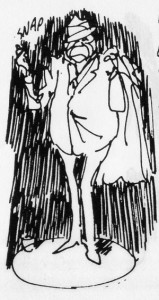 showed a mug’s face under a snap-brim hat, swaying on skinny legs and snapping his fingers:
showed a mug’s face under a snap-brim hat, swaying on skinny legs and snapping his fingers:
“I’m chairman of the Board. If some broad wantsa write a book about me… She gotta talk t’one of my boys who talks t’one of my other boys… who talks t’me. And MAYBE if the broad looks OK, I say, ‘Go Baby.’ Or Maybe I say ‘Shove it, Bimbo.’ And before she can write word one I sue her.
“So don’t give me any First Amendment crapola, I got the Frank Amendment and mine is bigger than hers. Ring a ding ding.”
After a year of litigation that cost me over $100,000 in legal fees, Sinatra finally dropped his lawsuit, but by then he had sent his message to my publisher and the rest of the world that he did not want the book written. Many people were too frightened to speak on the record, and some actually feared for their lives, but over the course of three years I managed to interview 800 people, including members of Sinatra’s family, his mistresses, co-stars, friends, neighbors, employees, FBI agents, a few antagonists, and a couple of mobsters.
In 1986 His Way: The Unauthorized Biography of Frank Sinatra was published, and– despite his threats– I lived to see the book become number one on the New York Times best seller list and sell more than 1 million copies in hardback. All very gratifying, but best of all was receiving ASJA’s Outstanding Author Award that year for “courageous writing on popular culture.”
Publication of the Frank Sinatra biography was a triumph for all non-fiction writers who struggle against immense pressure to find their way to examine the public figures who influence our society.
Thirty years ago ASJA made it possible for me to find my way– and for that I am profoundly grateful. I accept your award for Career Achievement because YOU made my career all it has been– and I thank you from the bottom of my heart.
by Kitty Kelley
ASJA Award
 The Board of the American Society of Journalists and Authors has voted to give Kitty Kelley the Founders’ Award for Career Achievement. According to Minda Zetlin, President, ASJA, “The award goes to a member whose ability to tell a story and whose style, range, and diversity of career exemplify the profession of independent nonfiction writer.” The award will be presented at a ceremony in New York on April 24, 2014.
The Board of the American Society of Journalists and Authors has voted to give Kitty Kelley the Founders’ Award for Career Achievement. According to Minda Zetlin, President, ASJA, “The award goes to a member whose ability to tell a story and whose style, range, and diversity of career exemplify the profession of independent nonfiction writer.” The award will be presented at a ceremony in New York on April 24, 2014.
Let Freedom Ring and Capturing Camelot Awards
Let Freedom Ring and Capturing Camelot both won USA Best Book awards.
More information here.
Let Freedom Ring won in the History: United States category. Read reviews of Let Freedom Ring here.
Capturing Camelot won in the Gift & Specialty Books category. Read reviews of Capturing Camelot here.
Kitty Kelley’s Capturing Camelot: Stanley Tretick’s Iconic Images of The Kennedys and Let Freedom Ring: Stanley Tretick’s Iconic Images of the March on Washington are available from Thomas Dunne Books in both hardcover and ebook formats.
Kitty Kelley on Book-TV
Kitty Kelley appeared on C-Span2’s Book-TV “In Depth” program on Sunday, Nov. 3, 2013, answering questions from host Peter Slen and from viewers for three hours. The show may be viewed online here.
The March to the Dream
by Kitty Kelley
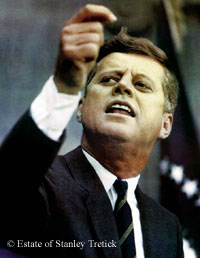 President Kennedy had to be pushed but after two bloody summers of Freedom Riders, television coverage of Bull Connors’ police dogs chewing children to bits, police men clubbing peaceful demonstrators and fire hoses slamming children against jagged brick buildings, leaving them torn and bleeding, JFK found his voice. He watched with disgust as Alabama Governor George Wallace, who had pledged “Segregation now. Segregation tomorrow. Segregation forever,” threatened to stand in the school house door to prevent two black students from integrating the state’s all-white university. That evening, June 11, 1963, John F. Kennedy ennobled his presidency with an address to the nation on equal rights:
President Kennedy had to be pushed but after two bloody summers of Freedom Riders, television coverage of Bull Connors’ police dogs chewing children to bits, police men clubbing peaceful demonstrators and fire hoses slamming children against jagged brick buildings, leaving them torn and bleeding, JFK found his voice. He watched with disgust as Alabama Governor George Wallace, who had pledged “Segregation now. Segregation tomorrow. Segregation forever,” threatened to stand in the school house door to prevent two black students from integrating the state’s all-white university. That evening, June 11, 1963, John F. Kennedy ennobled his presidency with an address to the nation on equal rights:
We are confronted primarily with a moral issue. It is as old as the Scriptures and as clear as the American Constitution…. If an American, because his skin is dark, cannot eat lunch in a restaurant open to the public, if he cannot send his children to the best schools available, if he cannot vote for the public officials who represent him…then who among us would be content to have the color of his skin changed? Who among us would then be content with counsels of patience and delay?
Next week I shall ask the Congress of the United States to make a commitment it has not fully made in this country to the proposition that race has no place in American life or law.
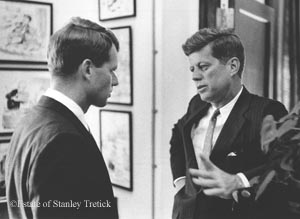 The President’s approval plummeted from 60 to 47 percent after his speech, and he and his brother, Attorney General Robert F. Kennedy, began counseling “patience and delay,” pleading with Civil Rights leaders to call off their scheduled March on Washington for Jobs and Freedom. Fearing violence and re-election in 1964, the administration said the March would do more harm than good. “We want success in Congress, not a big show at the Capital,” said the President.
The President’s approval plummeted from 60 to 47 percent after his speech, and he and his brother, Attorney General Robert F. Kennedy, began counseling “patience and delay,” pleading with Civil Rights leaders to call off their scheduled March on Washington for Jobs and Freedom. Fearing violence and re-election in 1964, the administration said the March would do more harm than good. “We want success in Congress, not a big show at the Capital,” said the President.
Kennedy summoned Civil Rights leaders to the White House to try to dissuade them but they remained resolute. The President relented and then called his brother: “Well, if we can’t stop them, we’ll run the damned thing.”
The March organizers agreed to demonstrate on a Wednesday so people would get back to their jobs and not stay the week-end. Parade permits were granted from 9 a.m to 5 p.m so that marchers would leave the city before dark. Schools, bars, restaurants and stores were closed. All elective surgeries in area hospitals were cancelled to free up 340 beds for riot-related emergencies. 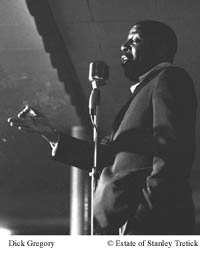 The DC National Guard spent the summer training for riot duty and 2400 Guardsmen were sworn in as “special officers” with temporary arrest power. The city, including leaders like Mrs. Agnes E. Meyer, whose family owned The Washington Post and Newsweek, predicted “catastrophic outbreaks of violence, bloodshed and property damage.” The government closed the day of the March and federal employees were told to stay home.
The DC National Guard spent the summer training for riot duty and 2400 Guardsmen were sworn in as “special officers” with temporary arrest power. The city, including leaders like Mrs. Agnes E. Meyer, whose family owned The Washington Post and Newsweek, predicted “catastrophic outbreaks of violence, bloodshed and property damage.” The government closed the day of the March and federal employees were told to stay home.
The comedian Dick Gregory was amused by the fears of the white establishment. “I know the senators and congressmen are scared of what’s going to happen,” he said. “[But] I’ll tell you what’s going to happen. It’s going to be a great Sunday picnic.” To the Kennedy administration it looked like it was going to be a great big political fiasco.
Weeks in advance, the March, set for August 28, 1963, became global news as Civil Rights activists around the world announced that they, too, would march in Berlin, Munich, Amsterdam, London, Oslo, Madrid, The Hague, Tel Aviv, Cairo, Toronto, and Kingston, Jamaica. 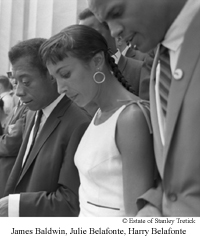 Celebrities chartered planes from Hollywood’s progressive community, including Harry Belafonte, Paul Newman, Marlon Brando, Gregory Peck, Billy Eckstein, Lena Horne, Sidney Poitier, Sammy Davis, Jr., Tony Bennett, even Charleton Heston. Burt Lancaster flew from his movie location in Paris, and the dancer and jazz singer Josephine Baker arrived from France in her Free French uniform.
Celebrities chartered planes from Hollywood’s progressive community, including Harry Belafonte, Paul Newman, Marlon Brando, Gregory Peck, Billy Eckstein, Lena Horne, Sidney Poitier, Sammy Davis, Jr., Tony Bennett, even Charleton Heston. Burt Lancaster flew from his movie location in Paris, and the dancer and jazz singer Josephine Baker arrived from France in her Free French uniform.
Even with unprecedented police presence on the Mall, the President was so concerned about hot rhetoric stirring the crowds to violence that he positioned one of his advance men behind the sound system at the Lincoln Memorial ready to flip a special switch to cut the public address system, if necessary, and play a recording of Mahalia Jackson singing, “He’s Got the Whole World in His Hands.”
The day dawned with Washington’s usual summer swamp humidity but most of the 250,000 marchers arrived in their Sunday best. Women donned hats and high heels; men wore white shirts and ties. They dressed for church; their mission was religious—to heal sick hearts and open closed minds.
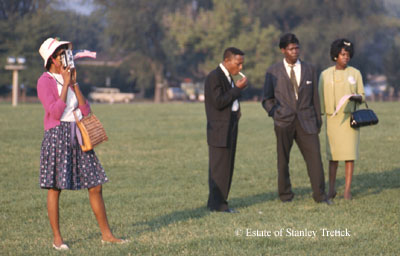
They marched and sang and swayed to the soaring sounds of the Freedom Singers and Odetta and Marian Anderson; they sat ten- deep at the Reflecting Pool, many dangling their feet in the water like pilgrims who once gathered at the Sea of Galilee.
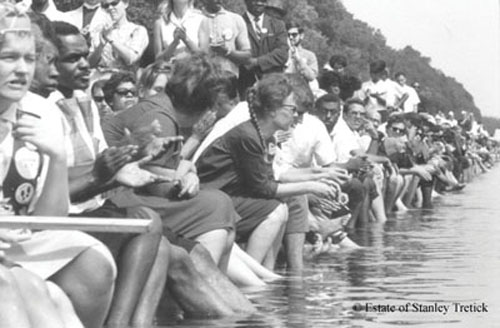
They cheered the speakers, and then they rose and roared in unison for the spell-binding finale of Martin Luther King, Jr., who had come to tell them about his dream for America “that one day the nation will rise up and live out the true meaning
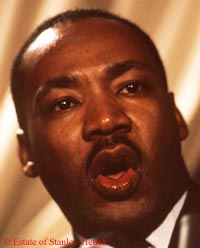 of its creed: ‘We hold these truths to be self-evident, that all men are created equal.’”
of its creed: ‘We hold these truths to be self-evident, that all men are created equal.’”
The vast throng of humanity erupted into thunderous applause with each crescendo of Dr. King’s dream. In the rising cadence of a master spell-binder, he told America that if it was to become a great nation, it must make the dream of freedom come true for its black citizens. Even President Kennedy, watching on television, was transfixed. “He’s good. He’s damn good.”
The President had refused to participate in the March, but he invited the Civil Rights leaders to the White House at the end of the day. He greeted Dr. King by shaking his hand and saying, “I have a dream.”
Bubbling over with the success of the day which had occurred without one incident of violence, the President told reporters that he was edified by the speeches, the singing, the crowds—the entire event. “The nation can be properly proud of this march,” he said.

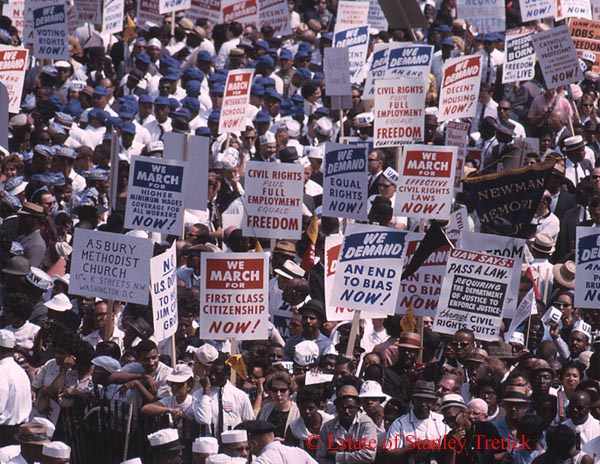
Photos from Let Freedom Ring: Stanley Tretick’s Iconic Images of the March on Washington, ©Estate of Stanley Tretick, used with permission.
Buy: Amazon Barnes & Noble Books-A-Million Apple IndieBound
Cross-posted from Huffington Post
Rose Kennedy: The Life and Times of a Political Matriarch
by Kitty Kelley
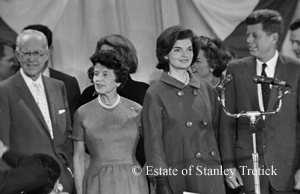 Anyone who has followed the Kennedys knows the bar is high for books on the subject. Having been inundated for the past 50 years with hundreds of biographies and memoirs and profiles about the spellbinding mystique of John Fitzgerald Kennedy, his family and his thousand days as the country’s first Irish-Catholic president, we expect each publication to bring something new and fresh to add to our understanding of the family that refashioned politics in the 20th century.
Anyone who has followed the Kennedys knows the bar is high for books on the subject. Having been inundated for the past 50 years with hundreds of biographies and memoirs and profiles about the spellbinding mystique of John Fitzgerald Kennedy, his family and his thousand days as the country’s first Irish-Catholic president, we expect each publication to bring something new and fresh to add to our understanding of the family that refashioned politics in the 20th century.
Serious historians (Arthur Schlesinger, Jr., William Manchester, James MacGregor Burns, Nigel Hamilton), journalists (Seymour Hersh, Jack Newfield, Warren Rogers), conspiracy theorists (Jim Garrison), commercial clip-and-pasters (Laurence Leamer, Christopher Anderson) and friends (Paul “Red” Fay, Benjamin C. Bradlee) have tried to capture the firefly magic of the Kennedys, while antagonists (Victor Lasky, Ralph de Taledano) have tried to puncture their myth.
So now comes Barbara A. Perry with Rose Kennedy: The Life and Times of a Political Matriarch, who promises to deliver “the definitive biography” of the woman whose iron-fisted image-making produced the mystique that continues to endure. When the John F. Kennedy Library released the papers of the president’s mother (300 boxes) in 2006, Perry, a senior fellow in presidential oral history at the University of Virginia’s Miller Center in Charlottesville, was first in line, but, alas, Rose had no secrets beyond the few she revealed in her 1974 memoir, Times to Remember. As a biographer Perry was challenged. After six years of research and writing, she bowed to the obvious: With nothing new, she went for nuance. Her text is well written and her bibliography shows research, but there is no gold in the mine.
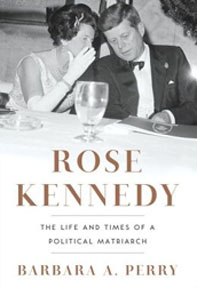 Her book cover, though, is perfect, absolutely perfect, because it captures the essence of Rose Fitzgerald Kennedy. The black-and-white photograph shows a woman who later died at the age of 104 after living her life by the black-and-white strictures of the Catholic Church, pre-Vatican II. Still glamorous at the age of 73, she is sitting next to the handsome president at a White House state dinner in 1963. She is acting as her son’s hostess because the first lady is away on one of her many vacations, similar to the ones Rose took for six to eight weeks at a time to get away from the clamor of her large family, and possibly, according to her biographer, as a means of Church-approved birth control. Rose is wearing the Molyneux gown she wore when she was 48 and her husband, Joseph P. Kennedy, was presented to the king and queen of England as the U.S. ambassador to the Court of St. James. That was the crowning glory of Rose’s life: To be accepted by British royalty was beyond the biggest dreams of a little girl from Dorchester, Mass.
Her book cover, though, is perfect, absolutely perfect, because it captures the essence of Rose Fitzgerald Kennedy. The black-and-white photograph shows a woman who later died at the age of 104 after living her life by the black-and-white strictures of the Catholic Church, pre-Vatican II. Still glamorous at the age of 73, she is sitting next to the handsome president at a White House state dinner in 1963. She is acting as her son’s hostess because the first lady is away on one of her many vacations, similar to the ones Rose took for six to eight weeks at a time to get away from the clamor of her large family, and possibly, according to her biographer, as a means of Church-approved birth control. Rose is wearing the Molyneux gown she wore when she was 48 and her husband, Joseph P. Kennedy, was presented to the king and queen of England as the U.S. ambassador to the Court of St. James. That was the crowning glory of Rose’s life: To be accepted by British royalty was beyond the biggest dreams of a little girl from Dorchester, Mass.
Bejeweled with two diamond clips in her hair, diamonds dripping from her ears, a triple strand of pearls the size of grapes circling her unlined neck and a bracelet of diamonds wrapped around her arm, which is encased in a long white kid-leather glove, Rose is whispering in her son’s ear. 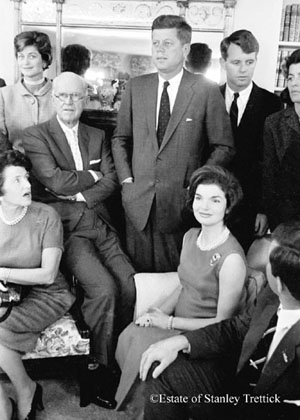 Ever the canny pol, she covers her mouth so the photographer cannot catch a candid shot. (“I do not like candid pictures,” she said. “They are so unattractive.”)
Ever the canny pol, she covers her mouth so the photographer cannot catch a candid shot. (“I do not like candid pictures,” she said. “They are so unattractive.”)
Oh, did I mention that the Molyneux gown was sleeveless? This is a detail Rose would want to have emphasized because she prided herself on her petite figure and frequently said that after having nine children she could still wear a size 8. Her frenetic exercise routine of swimming in the ocean every day, playing golf, walking miles, eating sparingly and rarely drinking had left her sleek and svelte with tanned, taut arms.
Appearances ruled Rose, and nothing mattered to her as much as how one looked — in person and in pictures. She made her children line up for daily inspections so she could see if their shoes were shined and their buttons attached. She saw each child as a reflection of herself and of the family name her husband was making famous on Wall Street and in Hollywood, so she strove for perfection, demanding it of herself and everyone around her. A martinet mother, she insisted her children brush their teeth three times a day and say their prayers every night. They were instructed to make meals on time or go without eating, and en route to the dining room they were required to check the bulletin board for the topics of current affairs that were to be discussed at dinner. Rose was the parent in charge of their childhood. When they became young adults her husband took over, but as one daughter said, “Dad gave us many lovely things but mother gave us our character.”
Despite her foibles and her husband’s philandering Rose relied on her strong religious faith to survive the worst tragedies of her life, and she managed to produce an extraordinary family of sons and daughters, who cared for each other, supported each other and remained close throughout their lives — and that is a mother’s finest legacy. Rose Fitzgerald Kennedy is an admirable subject but one that left her admiring biographer empty-handed.
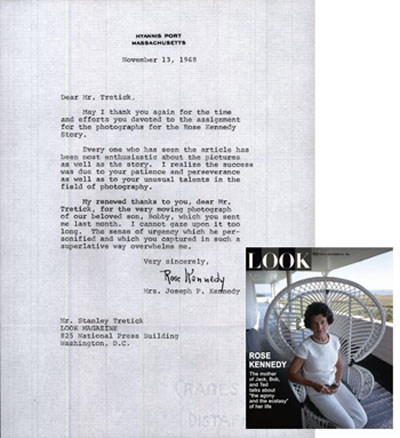 Kitty Kelley’s seven biographies include Jackie Oh! (1978), the first book to reveal that the former first lady suffered from depression and was treated with electroshock therapy; it also reported for the first time that Rosemary Kennedy survived the mangled lobotomy her father had ordered in hopes of reversing her mental retardation. In 1988, People published Kelley’s story detailing President Kennedy’s affair with a woman who carried his messages to her other lover, mobster Sam Giancana.
Kitty Kelley’s seven biographies include Jackie Oh! (1978), the first book to reveal that the former first lady suffered from depression and was treated with electroshock therapy; it also reported for the first time that Rosemary Kennedy survived the mangled lobotomy her father had ordered in hopes of reversing her mental retardation. In 1988, People published Kelley’s story detailing President Kennedy’s affair with a woman who carried his messages to her other lover, mobster Sam Giancana.
Cross-posted with Washington Independent Review of Books.
Photos from Capturing Camelot ©Estate of Stanley Tretick, used with permission.
Gaithersburg Book Festival
On May 18, 2013 (Saturday), Kitty Kelley will be appearing at the Gaithersburg Book Festival, Gathersburg MD. Author presentation at James Michener Pavilion, 1:15 pm to 2:05 pm. Book signing (Capturing Camelot) 2:15 to 3:05 pm, Politics and Prose Signing Area. Click here for more details.
Goosey Lucy and Gay Marriage
by Kitty Kelley
Gay marriage has jumped out of the closet on to the front page. Everyone from the President of the U.S. to retired four star general Colin Powell is embracing the issue, now supported by most Americans. Still, a few people like former First Lady Laura Bush appear to be conflicted. This week Mrs. Bush, who publicly supported gay marriage, now objects to appearing in an ad that carries her words of support.
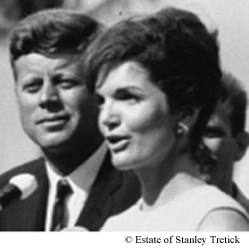 Presidents often disappoint, but first ladies rarely do. I became a student (and secret admirer) of first ladies after writing biographies of Jacqueline Kennedy Onassis (1978), Nancy Reagan (1991) and Barbara and Laura Bush (2004). Through years of research and reporting I’ve watched these unelected women enhance the presidencies of their spouses through deed and demeanor. They all seem to do it with style and grace and as a result they usually become even more popular than their beleaguered husbands (Lady Bird Johnson, Betty Ford and Michelle Obama).
Presidents often disappoint, but first ladies rarely do. I became a student (and secret admirer) of first ladies after writing biographies of Jacqueline Kennedy Onassis (1978), Nancy Reagan (1991) and Barbara and Laura Bush (2004). Through years of research and reporting I’ve watched these unelected women enhance the presidencies of their spouses through deed and demeanor. They all seem to do it with style and grace and as a result they usually become even more popular than their beleaguered husbands (Lady Bird Johnson, Betty Ford and Michelle Obama).
These warrior goddesses stand stalwart in the face of their husbands’ scandals (Pat Nixon and Watergate; Nancy Reagan and Iran Contra; Hillary Clinton and Monica Lewinsky). They protect their young (Jacqueline Kennedy); they beautify their environment (Lady Bird Johnson) and they do good for others, even after leaving the White House. (The Betty Ford Clinic provides treatment for alcoholism; the Barbara Bush Foundation raises money for literacy; Rosalynn Carter travels the world for the Carter Center to promote mental health, and at the age of 91 Nancy Reagan still campaigns for expanded stem cell research.)
As first ladies these women stay above the political fray, avoid divisive muck, and glide like swans across ponds of public good will. Most write commercially successful memoirs of their days in the White House, where they became beatified, and as the wives of former presidents they continue burnishing their husbands’ legacies as well as their own.
For the most part first ladies seldom falter, which is why it was disappointing to read about the wife of a self-described “compassionate conservative” former president fumble on an issue of equal rights.
A group known as Respect for Marriage Coalition had launched a $1 million multi-media campaign last week that featured President Obama, former Vice President Dick Cheney, former Secretary of State Colin Powell and Mrs. Bush in their own words expressing support for the marriage rights of all committed couples. The group had taken what Laura Bush had said on the subject to Larry King on television: “When couples are committed to each other and love each other, then they ought to have, I think, the same sort of rights that everyone has.”
The former first lady’s words had reassured many who recalled with dismay her husband’s hard line on homosexuality. As Governor of Texas, George W. Bush said he supported the state’s law against sodomy “as a symbolic gesture of traditional values.” He opposed hate crimes legislation that would have protected gays. He also opposed gay adoption and gay marriage, and as President he proposed a constitutional amendment prohibiting same-sex unions.
 Granted, Laura Bush did not oppose her husband until after he had left the White House and would not have to pay the consequence of her words, but that seems to be in the tradition of Bush wives. Barbara Bush also waited until her husband, an ardent foe of abortion for twelve years, was no longer president before she declared publicly that abortion should be a “personal choice” and that she was pro-choice.
Granted, Laura Bush did not oppose her husband until after he had left the White House and would not have to pay the consequence of her words, but that seems to be in the tradition of Bush wives. Barbara Bush also waited until her husband, an ardent foe of abortion for twelve years, was no longer president before she declared publicly that abortion should be a “personal choice” and that she was pro-choice.
A year after Laura Bush’s 2010 interview on CNN, her daughter, Barbara Bush, taped a video for the Human Rights Campaign, now a sponsor of the Marriage Coalition. To date the former first lady’s daughter has not withdrawn her support for gay rights, but when Mrs. Bush saw her support in the Coalition’s television ad last week she immediately directed her spokeswoman to contact the media to say that the former first lady “did not approve of her inclusion in this advertisement nor is she associated with the group that made the ad in any way.”
The Coalition, comprised of 80 civil rights, family, health, labor, business, student, LGBT and women’s organizations, withdrew the ad in deference to Mrs. Bush and issued a statement, explaining they had used public comments from American leaders of both political parties who had expressed their support for civil marriage. “We appreciate Mrs. Bush’s previous comments but are sorry she didn’t want to be included in an ad.”
One can only wonder why the former first lady chose to backtrack on an issue that is supported by most Americans, who believe that marrying the person you love is a fundamental freedom and Constitutional right for everyone, including gays and lesbians. Polls show that a majority of the country believes that continuing to deny gays and lesbians the freedom to marry constitutes discrimination, and those who personally oppose marriage equality accept that it is likely to become a reality within the next decade. Even Congress has jumped on board. Bills were introduced in the Senate and the House this month to change the definition of “spouse” in the U.S. Code so that same-sex married service members can get equal benefits.
 Surely Laura Bush, a former librarian, who as First Lady frequently posed for photographs reading to children, knows the folk tale of Chicken Little, who believes the sky is falling when an acorn drops on her head. Terrified, she decides she must tell the King and on her journey to the castle she meets a goose, a hen and a turkey– Goosey Lucy, Henny Penny and Turkey Lurkey. Within moments they are cornered by a fox–Foxy Loxy–who threatens to eat them. In the happily-ever-after version only Goosey Lucy escapes. The morale, we are told, is not to be a chicken but to have the courage to stand up–a quality found in most first ladies.
Surely Laura Bush, a former librarian, who as First Lady frequently posed for photographs reading to children, knows the folk tale of Chicken Little, who believes the sky is falling when an acorn drops on her head. Terrified, she decides she must tell the King and on her journey to the castle she meets a goose, a hen and a turkey– Goosey Lucy, Henny Penny and Turkey Lurkey. Within moments they are cornered by a fox–Foxy Loxy–who threatens to eat them. In the happily-ever-after version only Goosey Lucy escapes. The morale, we are told, is not to be a chicken but to have the courage to stand up–a quality found in most first ladies.
Cross-posted from Huffington Post

